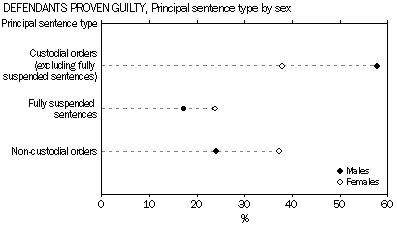|
|
Publications
Copies of all publications can be ordered by contacting the ABS National Information and Referral Service on 1300 135 070.
Criminal Courts, Australia (4513.0)
On 25 February 2004, the ABS released Criminal Courts, Australia 2002-03, more than 6 weeks earlier than last year’s release. The publication provides a picture of the characteristics of defendants dealt with by the Higher Criminal Courts, including information on the offences and sentence types associated with those defendants. Magistrates’ Criminal Courts data are also available on an experimental basis.
Of the 16,643 finalised Higher Criminal Court defendants in 2002-03, almost 90% were finalised by adjudication (proven guilty or acquitted). Of these adjudicated defendants:
- Of all defendants, nearly nine in ten (87%) were men and half were men aged between 20-34 years.
- Men were more likely than women to have a principal offence of sexual assault and related offences (12% of men, compared to 1% of women).
- Women were more likely than men to have a principal offence of deception and related offences (19% of women, compared to 6% of men).
- Defendants finalised at trial (guilty verdict or acquitted) with a principal offence of homicide and related offences had an acquittal rate of 36%. The acquittal rate for those with a principal offence of sexual assault and related offences was 51%.
- Most defendants were proven guilty (93%). The proportion of defendants proven guilty was highest for unlawful entry with intent and dangerous or negligent acts endangering persons (both 98%).
- The proportion of defendants proven guilty for illicit drug offences, theft and related offences, and deception and related offences was 97% each.
- Over one-third of women proven guilty received a non-custodial sentence, compared to less than one-quarter of men.
- Just over half of defendants proven guilty (55%) received custodial orders to be served (excluding fully suspended sentences). For both men and women, these were the main sentence types, although the proportion was higher for men (58%) than women (38%).

- The proportion of Indigenous people in the prison population has risen from 15% to 20%.
- The mean age of prisoners has increased from 31 years to 34 years.
- The proportion of unsentenced prisoners has increased from 12% to 20%.
- The proportion of sentenced prisoners serving an aggregate sentence length of 10 years or more has increased from 9% to 13%.
- Sentenced prisoners with a most serious offence of homicide and related offences increased from 9% to 10% and assault from 11% to 13%.
At June 2003, there were 23,555 prisoners in Australia, an increase of 5% since 30 June 2002. The mean aggregate sentence length was
4.9 years and the mean expected time to serve was 3.2 years.
Other findings as at 30 June 2003 include:
- Indigenous prisoners were proportionally more likely to be serving shorter sentences than the overall prisoner population, with 42% of Indigenous prisoners expected to serve less than 12 months. This is compared with 31% of all prisoners.
- Nearly 55% of prisoners were males aged 20-34 years.
- Females represented 7% of the total prisoner population.
- Almost 60% of male prisoners and 50% of female prisoners are known to have prior imprisonment.
- Nearly 1 in 2 sentenced prisoners had a most serious offence involving violence or the threat of violence.
Corrective Services, Australia (4512.0)
The December quarter 2003 issue of Corrective Services, Australia was released on 25 March 2004. This publication presents time series information on persons in custody and community-based corrections. Details are provided by state/territory on prisoner counts and rates of imprisonment by type of custody, legal status, sentence type and Indigenous Status.
Between the December quarters 2002 and 2003 the number of unsentenced prisoners rose from 4,470 to 4,851, an increase of 9%. Unsentenced prisoners represented 21% of all persons in custody in the December quarter 2003.
|
|
 Print Page
Print Page
 Print All
Print All